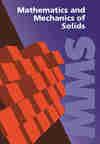Analysis of planar arbitrarily curved microbeams with simplified strain gradient theory and Timoshenko–Ehrenfest beam model
IF 1.7
4区 工程技术
Q3 MATERIALS SCIENCE, MULTIDISCIPLINARY
引用次数: 0
Abstract
As the first endeavor in the context of Mindlin’s strain gradient theory, this study contributes a systematic and rigorous derivation for governing equations and boundary conditions of planar arbitrarily curved microbeams. The Timoshenko–Ehrenfest beam model is incorporated into a simplified version of Mindlin’s strain gradient theory. Kinematic unknowns include displacement components of the beam axis in the local coordinate system and the rotation of cross-section. Since the derived governing equations and boundary conditions are extremely complex, analytical solutions are not achievable for microbeams having non-uniform curvature. To facilitate the numerical analysis, two isogeometric collocation formulations are proposed, that is, displacement-based and mixed formulations. Several tests are designed to evaluate the accuracy and reliability of the proposed isogeometric collocation formulations, especially with respect to the well-known locking pathology. It is found that the mixed formulation is more accurate and robust than the displacement-based one. Therefore, the mixed formulation is then used to numerically investigate the size-dependent behavior and stiffening effect. Furthermore, some informative tests are performed to delineate the significance of the curviness in the prediction of structural responses of planar arbitrarily curved microbeams, which appears to be still an unanswered issue.用简化应变梯度理论和 Timoshenko-Ehrenfest 梁模型分析平面任意弯曲微梁
作为在 Mindlin 应变梯度理论背景下的首次尝试,本研究对平面任意弯曲微梁的控制方程和边界条件进行了系统而严格的推导。Timoshenko-Ehrenfest 梁模型被纳入 Mindlin 应变梯度理论的简化版本。运动未知量包括梁轴在局部坐标系中的位移分量和横截面的旋转。由于推导出的控制方程和边界条件极其复杂,因此对于曲率不均匀的微梁来说,无法获得解析解。为了便于数值分析,提出了两种等几何配位公式,即基于位移的公式和混合公式。设计了几个测试来评估所提出的等距配位公式的准确性和可靠性,特别是在众所周知的锁定病理学方面。结果发现,混合公式比基于位移的公式更精确、更稳健。因此,混合公式被用于数值研究与尺寸相关的行为和刚化效应。此外,我们还进行了一些内容丰富的测试,以确定曲率在预测平面任意弯曲微梁结构响应中的重要性,这似乎仍是一个尚未解决的问题。
本文章由计算机程序翻译,如有差异,请以英文原文为准。
求助全文
约1分钟内获得全文
求助全文
来源期刊

Mathematics and Mechanics of Solids
工程技术-材料科学:综合
CiteScore
4.80
自引率
19.20%
发文量
159
审稿时长
1 months
期刊介绍:
Mathematics and Mechanics of Solids is an international peer-reviewed journal that publishes the highest quality original innovative research in solid mechanics and materials science.
The central aim of MMS is to publish original, well-written and self-contained research that elucidates the mechanical behaviour of solids with particular emphasis on mathematical principles. This journal is a member of the Committee on Publication Ethics (COPE).
 求助内容:
求助内容: 应助结果提醒方式:
应助结果提醒方式:


